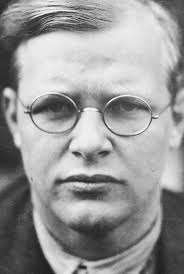"Those who don't know history are destined to repeat it."
(Edmund Burke, 1729-1797, Irish political philosopher)
Early on a gray spring morning in Flossenbürg, Germany, Dietrich Bonhoeffer, was taken from his cell, marched naked to the gallows, and hanged. The prison doctor later wrote a brief account of his last moments:
"Through the half-open door in one room of the huts I saw Pastor Bonhoeffer, before taking off his prison garb, kneeling on the floor praying fervently to his God. I was most deeply moved by the way this unusually lovable man prayed, so devout and so certain that God heard his prayer. At the place of execution, he again said a short prayer and then climbed the steps to the gallows, brave and composed. His death ensued after a few seconds. In the almost fifty years I worked as a doctor, I have hardly ever seen a man die so entirely submissive to the will of God."*
While virtually everyone now regards Bonhoeffer as a martyr to his faith, it is revealing to observe that at the end of the war, his home church refused to honor him as such, drawing a sharp line between those men and women who died for their Christian faith and those who died because of their resistance to the Nazi state. Perhaps this should not surprise us.
One of the most lamentable stories in all the history of Christianity must be the failure of the church in Germany to stand not only against Hitler and the Nazi movement, but to stand against the things that allowed fascism to flourish in Germany. There were notable exceptions in this sad history, of course; Martin Niemöller stands as an example of one whose faith placed boundaries upon the claims of his patriotism. But the relative paucity of exceptions (their notability, in fact) only makes the reality more painful. Christians became complicit in the crimes of the Nazi state, sometimes by remaining silent, and sometimes as enthusiastic and active participants.
Jack Forstman, in his remarkable study, Christian Faith in Dark Times: Theological Conflicts in the Shadow of Hitler, begins his book by quoting Kurt Tucholsky, a brilliant German Jew, who wrote: "Nothing is more difficult and nothing requires more character than to find oneself in open opposition to one's time and to say loudly: No."** And, if that "No!" must be spoken in opposition not only to one's time, but also to the leadership of one's country, to the followers of that leadership, and to one's own church, how much more character does it require?
It is so easy - it is too easy - as a Christian living in the United States in the second decade of the twenty-first century to stand in judgment of German Christians in the 1930s, to pretend that if we had been in Germany in the time of Bonhoeffer, we would have been his supporters and his colleagues, and that we would have stood with him against fascism.
We ask:
Did the German Christians not see the evil of the anti-Semitism that raged in their society?
Did they not understand that their facile endorsement of Hitler, their glorification of "German soil" and the myths of the Aryan race, and their subordination of their Christian Faith to the platform of the Nazi party were demonic?
Could they not discern that equating patriotism with nationalism, and nationalism with militarism was mistaken?
Their sins seem so clear to us. Why did they not see them?
We, American Christians, can see the impediment in the German eye (it was so much bigger than the "mote" of Jesus' story that we don't require a magnifying glass to see their faults!). But, of course, the question is: Can we see the plank in our own eye?
Surely one of the questions that has mystified historians of the twentieth century has been this: How could a nation as civilized, sophisticated and scientifically advanced as Germany allow itself to be seduced by Nazism and Hitler's band of thugs, con men, racists and sadists? However, a question that inevitably arises from this question about twentieth-century Germany is a question much closer to home: Could what happened in Germany then happen here now?
This latter question is not merely academic. It is a question that goes to the heart of what it means to be both a Christian and a citizen of the United States. It is an intensely personal question as well as a political one. And it is a question, ultimately, of faith. It is a question with which we must wrestle today, especially today, as Christians and as Americans.
To answer this question, we must reflect on the Germany into which Bonhoeffer was born, a country that had produced some of the greatest minds and spirits of all time, from Luther and Bach to Kant, Schleiermacher and Schweitzer; a country also, however, haunted by economic strife, long-nursed grievances and smoldering resentments; a people apparently all-too-ready to believe racist mythologies and political conspiracies, to trust violence and a mob mentality more their own democratic processes and institutions. We must also consider the religious bigotry and racism that sadly the church did little to counter and much to promote and on one bright and shining moment in Barmen when the church rose up to speak against fascism, though it was such a brief moment of light which the darkness soon prevailed against.
Perhaps these reflections will raise more questions than they can possibly answer. But sometimes just raising a question can be edifying.
*Eberhard Bethge, Dietrich Bonhoeffer: A Biography (Minneapolis: Fortress Press, 2000), pp. 927-928.
**Jack Forstman, Christian Faith in Dark Times (Louisville: Westminster John Knox Press, 1992), p. 11.

